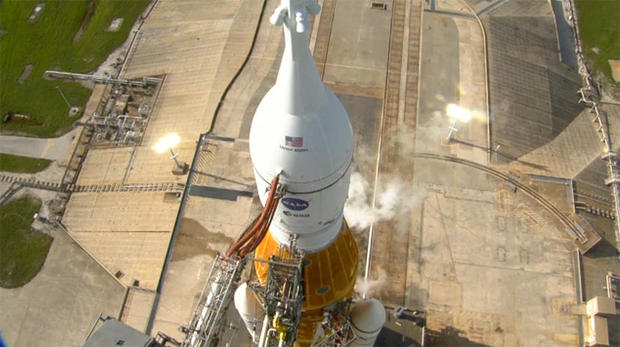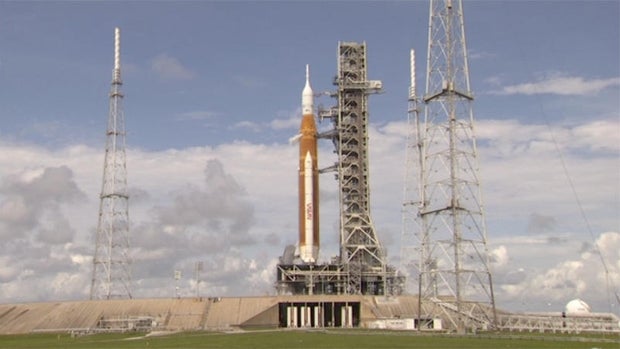NASA’s star-crossed Space Launch System moon rocket was grounded Saturday for the second time in five days after engineers tried and failed to remotely stop a hydrogen leak in a quick-disconnect fitting where propellants are fed into the giant booster’s first stage.
Engineers made three attempts to properly “seat” a suspect seal in the 8-inch fitting, but none of them worked and after a “no-go” recommendation from the engineers working the problem, Launch Director Charlie Blackwell-Thompson called off the countdown at 11:17 a.m. EDT.
NASA
“The team now going into the cutoff procedure after being unable to resolve a hydrogen leak,” said NASA countdown commentator Derrol Nail. “The vehicle is safe. NASA Test Director Jeff Spaulding now putting the team into a configuration to drain propellants from the tank.”
NASA managers planned to meet later in the day to discuss the plan forward: whether to make another launch attempt Monday or Tuesday, assuming repairs are possible at the pad, or whether to haul the rocket back to the Vehicle Assembly Building for already scheduled servicing.
In that case, launch on the Artemis 1 test flight likely would slip to mid-October.
“We’ll go when it’s ready,” said NASA Administrator Bill Nelson. “We don’t go until then, especially now, on a test flight. … This is part of our space program, be ready for the scrubs.”
The latest delay was a frustrating disappointment to the Kennedy Space Center work force, invited guests and thousands of area residents and tourists who lined area roads and beaches to watch NASA’s most powerful rocket blast off, raising the curtain on the agency’s Artemis moon program.
The goal of the Artemis 1 mission is to boost an unpiloted Orion capsule into a distant orbit around the moon, testing the spacecraft in the deep space environment before returning it to Earth for a high-speed, high-temperature re-entry.
If the initial uncrewed test flight goes well, NASA plans to launch four astronauts on an around-the-moon shakedown flight — Artemis 2 — in 2024 and to land the first woman and next man near the moon’s south pole the 2025-26 timeframe. But all of that hinges on a successful Artemis 1 test flight.
The long-awaited mission must take off during specific launch periods based on the constantly changing positions of the Earth and moon, the desired lunar orbit for the Orion spacecraft and the power of the SLS rocket to put it on the proper trajectory.
Complicating the planning, flight planners want to avoid putting the solar-powered spacecraft in the moon’s shadow for extended periods and they want to ensure a daylight splashdown.
The current launch period ends Tuesday. If the SLS rocket isn’t off the pad by then, it will have to be hauled back to the Vehicle Assembly Building to service batteries in its self-destruct system, a requirement that has nothing to do with the latest hydrogen leak.
The next launch period opens Sept. 19 and runs through Oct. 4, but NASA plans to launch its next crew to the International Space Station aboard a SpaceX Crew Dragon capsule on Oct. 3. The next lunar launch period after that opens Oct. 17 and runs through Halloween.
Already running years behind schedule and billions over budget, NASA attempted to launch the SLS rocket on its maiden flight Monday after four countdown rehearsals and fueling tests, all of which ran into multiple technical snags, including hydrogen leaks in different systems.
During Monday’s launch attempt, a faulty temperature sensor led to uncertainty as to whether the SLS rocket’s four RS-25 first stage engines were receiving the proper pre-launch cooling.
That cooling, or conditioning, is required to avoid damaging bearings in high-pressure fuel pumps if “shocked” with cryogenic propellant at minus 423 degrees Fahrenheit.
NASA
After an unsuccessful attempt to increase cooling by forcing liquid hydrogen through the engine plumbing at higher pressure, Blackwell-Thompson called off the countdown and ordered a scrub.
A hydrogen leak in a different part of the launch pad umbilical system also cropped up Monday, but engineers managed to resolve that one and press ahead with fueling before the engine cooling question came to light.
As it turned out, the engines were, in fact, being properly cooled and a faulty temperature sensor was responsible for misleading engineers.
During Saturday’s launch attempt, fueling began on time but higher-than-allowable levels of gaseous hydrogen were detected near the SLS rocket’s cramped engine compartment where liquid hydrogen is fed in through launch pad umbilicals that retract at the moment of liftoff.
The presence of gaseous hydrogen indicated a leaking seal in a specific 8-inch quick-disconnect fitting.
In an initial attempt to resolve the issue, hydrogen flow was stopped and the temperature of the hardware was allowed to equalize across both sides of the fitting. When the flow of cryogenic fluid resumed, engineers hoped, the sudden thermal shock of the ultra-cold propellant might re-seat the leaking seal.
But that didn’t work. A second attempt used helium to increase pressure in the line, again with the goal of pushing the seal into position. But as soon as hydrogen started flowing again, sensors again detected a leak.
At that point, a variety of options were discussed but in the end, engineers decided to fall back on Plan A, warming up the hardware and then shocking it again with cryogenic hydrogen. And again, the fitting leaked.








